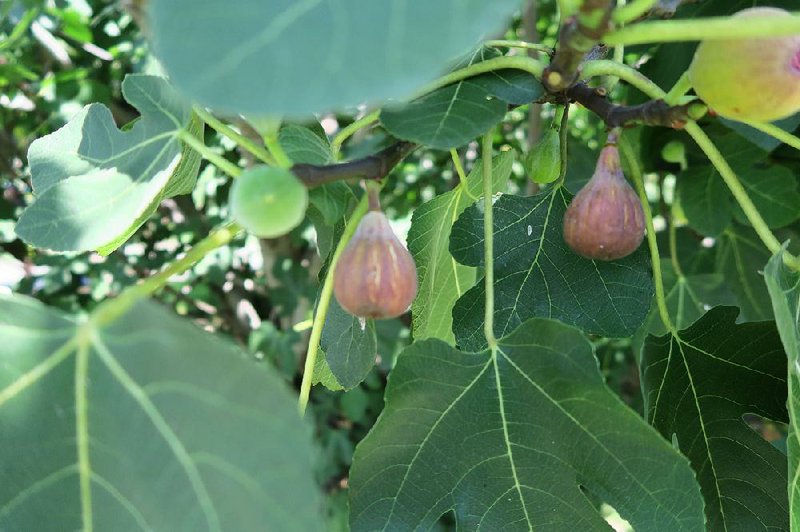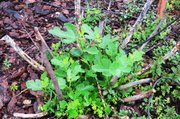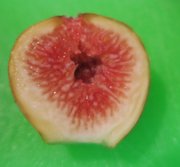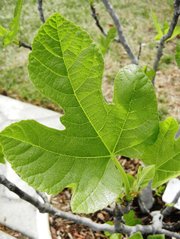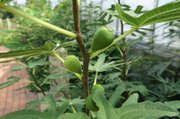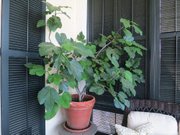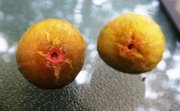For many gardeners, 2016 may be called the Year of the Fig. Fig trees are loaded with fruit, which is a welcome change from the past two years, when winter damage lowered the harvest.
The common fig (Ficus carica) can be grown throughout Arkansas, but hardiness does vary among its cultivars. Figs are considered a deciduous tree, but in colder climates they tend to become large bushes: They can be killed back by temperature much below 15 degrees.
Figs are a member of the mulberry family (Moraceae) and are related to many familiar houseplants, including the ficus tree or weeping fig (Ficus benjamina), rubber tree (Ficus elastica) and the fiddleleaf fig (Ficus lyrata). Our common fig is the only hardy member of the Ficus genus and the only one that produces an edible fruit.
Figs rank among the oldest fruit crops known to man and have long been grown in the South.
If they aren't nipped back in winter, the trees can reach 25 or 30 feet tall and equally as wide. If space is limited, they can be pruned to maintain a more reasonable size. Even if they are frozen back to the soil line, typically they will resprout from the roots and may bear some fruit that year, since they can set fruit on the current season's growth.
There are four distinct horticultural types of figs (common, Smyrna, San Pedro and Caprifig) but only the common fig survives in our climate. There are several common fig varieties that grow well in Arkansas, and all are readily available. (In California, Greece and other climates, there are species that depend on small wasps to enter the fig to pollinate the fruit, but we don't grow those types in Arkansas.)
While there are more than 700 fig cultivars, only about 50 are offered in the nursery trade in the United States. But there is quite a bit of name confusion among fig cultivars, so don't be surprised to see the same plant grown under several names.
TWO POPULAR CULTIVARS
The two most common varieties of figs you can find in Arkansas are "Celeste" and "Brown Turkey," but researchers are
experimenting with other cultivars.
"Celeste" is the most cold-hardy of the figs we grow. It produces a small brown fig. It usually ripens before "Brown Turkey" and has a tightly closed "eye" on the end of the fruit opposite the stem, which can prevent infestation by the fruit beetle and fruit souring. Fruit souring is a condition that occurs when water enters the fig through this eye. Souring causes the fruit to rot.
Although "Celeste" is more cold tolerant than "Brown Turkey," it does not rebound as quickly from winter damage or heavy pruning. If you severely prune a "Celeste" fig in late winter, it will greatly limit your crop that season.
"Brown Turkey" (also called "Texas Everbearing") ripens a few weeks after "Celeste." While "Brown Turkey" is a little less hardy than "Celeste," it tends to bear more fruit even when it is winter damaged or severely pruned, and rebounds faster. It also bears for a relatively long period of time.
BEST CONDITIONS
While we rarely have a wet August, this year with all the rain we have seen some fruit cracking and souring. Fruit souring tends to be worse when rain is followed by high temperatures.
Figs will produce best when planted in a well-drained soil in full sun. They have a fibrous, shallow root system, which makes them sensitive to drought stress. If your fig tree gets too dry, it will drop fruit. But fruit drop also can be caused by storms, cool weather soon after the fruit sets and general weakness in the tree.
Our roller coaster winter weather, with swings in temperatures, can cause mild to severe winter injury -- most commonly in the state's northern counties. The farther north you live in the state, the more protection the tree might need. Planting on the eastern side of the house or with a rock or brick wall at the tree's back to block the winds and radiate heat will offer some protection from cold weather. But the tree still needs a minimum of six to eight hours of sunlight if you hope to harvest fruit.
HIDDEN FLOWER
The common fig fruit is unique. It is "parthenocarpic," meaning the fruit is formed without being pollinated. Unlike most fruit in which the part we eat is matured ovary tissue resulting from fertilization, the fig's edible structure is actually fleshy stem tissue.
The fig fruit is an inverted flower that contains the flower parts enclosed in stem tissue -- the blossom is inside the fruit. This structure is known botanically as a syconium.
At maturity, the interior of the fig contains only the remains of these flower structures, including the small crunchy structures commonly called seeds. Actually, these so-called seeds usually are nothing more than unfertilized ovaries that failed to develop.
In milder climates, figs can produce two crops. One crop is set at the end of the season and is supposed to overwinter on the trees and be harvested in early spring. This crop is called the "breba" crop. Rarely do any breba figs overwinter in Arkansas. The second crop is what is produced on the current season growth, and that is predominantly what we harvest in Arkansas.
Fig trees produce large, somewhat tropical-looking leaves with five rounded lobes. Figs can be planted as edible ornamentals.
COMPETITION
Figs have very few pests and don't require rigorous spray schedules like other tree fruits; in fact, they normally don't require any spraying and can be grown completely "organically."
They can produce a lot of fruit, and when they are in production, daily picking may be needed. The trees do produce a white latex sap that irritates some people's skin. If you experience problems, wear gloves when picking.
Figs must be ripened on the tree, and they are quite perishable.
Birds, squirrels and raccoons like them just as much as people do. Bird netting can help. You also want to pick the fruit as soon as it ripens, to prevent decaying or splitting. Split or decayed fruit attracts wasps, bees, ants and flies, which can make future picking more difficult.
FUTURE FIGS
Figs are easily propagated by cuttings or by layering branches of an existing fig tree down into the soil. If you want to buy and plant new fig trees, plant them in late winter through late spring to allow them time to get established before they have to contend with the next winter's weather.
Janet B. Carson is a horticulture specialist for the University of Arkansas Cooperative Extension Service.
HomeStyle on 08/20/2016
